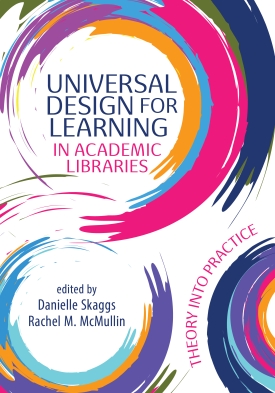Primary tabs
You don't need to be an ALA Member to purchase from the ALA Store, but you'll be asked to create an online account/profile during checkout to proceed. This Web Account is for both Members and non-Members. Note that your ALA Member discount will be applied at the final step of the checkout process.
If you are Tax-Exempt, please verify that your account is currently set up as exempt before placing your order, as our new fulfillment center will need current documentation. Learn how to verify here.
- Description
- Table of Contents
- About the authors
Universal Design for Learning (UDL) is an educational framework for improving and optimizing teaching and learning. It’s focused on intentionally designing for the needs and abilities of all learners—putting accessibility into the planning stages instead of as an accommodation after the fact—and providing flexibility in the ways students access and engage with materials and learning objectives.
In four parts, Universal Design for Learning in Academic Libraries: Theory into Practice explores UDL:
- Theory and Background
- In Instruction and Reference
- Behind the Scenes
- Beyond the Library
Chapters include looks at UDL and U.S. law and policy; working with student disability services to create accessible research services; UDL and the ACRL Framework for Information Literacy in Higher Education and the Reference and User Services Association’s “Guidelines for Behavioral Performance of Reference and Information Service Providers”; making open educational resources equitable and accessible; and much more. There are lesson plans and strategies for the wide range of instructional activities that occur in academic libraries, including in-person, online, synchronous, asynchronous, and research help, as well as different types of academic library work such as access services and leadership.
Universal Design for Learning in Academic Libraries can make learning about UDL and implementing it into your work quicker and easier, and provides ways to become an advocate for UDL inside your library and across campus.
Preface
Part I: UDL Theory and Background
Chapter 1. An Overview of UDL Theory and Scholarship in Higher Education
Rachel M. McMullin and Danielle Skaggs
Chapter 2. What’s Law Got To Do With It? Universal Design for Learning and Federal Policies in The United States
Stefanie Havelka
Chapter 3. UDL and the Reference Interview
Hannah Loewen, Gwendolyn B. Peart, Bethany Radcliffe, and Garrett B. Trott
Part II: UDL in Instruction and Reference
Chapter 4. Reaching All Researchers: Working with Student Disability Services to Create Accessible Research Services
Mary Margaret Cornwell
Chapter 5. Information Literacy and Learning Activities for All: Combining Universal Design for Learning with the ACRL Framework for Information Literacy for Higher Education
Sandy Hervieux
Chapter 6. UDL as a Framework for Expanding Liaison Work and Engaging with Students
Erica DeFrain
Chapter 7. From Theory to Practice: Using UDL to Move Library Instruction and Support Online
Jenny Dale and Samantha Harlow
Chapter 8. Designing for Everyone: Accessibility, Inclusion, and Equity in Online Instruction
Kimberly Shotick
Chapter 9. Combining UDL and Digital Accessibility Principles to Create Inclusive Learning Experiences in Libraries
Elisabeth B. White
Chapter 10. Implementing UDL Using an Interactive LibWizard Tutorial to Reach the Needs of Community College Students
Madeline Ruggiero
Chapter 11. LibGuides and Universal Design for Learning: A Case Study for Improving the Accessibility of Research Guides
Lauren Kehoe and Iris Bierlein
Part III: UDL Behind the Scenes
Chapter 12. Open Universal Design for Learning: Working to Make Open Educational Resources Equitable and Accessible
Samantha Peter and Hilary Baribeau
Chapter 13. Using the Instructional Design Process to Effectively Apply UDL to OER: Considerations, Limitations, and Best Practices
Michael Chee and Kari D. Weaver
Chapter 14. Applying UDL Guidelines to OER Marketing and Outreach
Sabrina Davis
Chapter 15. A Visual Workflow for Cataloging
Arden Kirkland and Minor Gordon
Chapter 16. Setting Achievable Goals to Meet High Expectations: One Library’s Approach to Universal Design for Learning (UDL) and Accessibility Standards
Victoria Eastes, Lisa Kallman Hopkins, Bridgit McCafferty, and Johnnie Porter
Chapter 17. UDL: Universal Design for Learning or Universal Design for Leadership?
Garrett B. Trott
Part IV: UDL Beyond the Library
Chapter 18. Removing Barriers with Assignment Design
Urszula (Ula) Lechtenberg
Chapter 19. UDL in the Library and Beyond
Breanne A. Kirsch and Katelyn Sabelko
About the Authors
Danielle Skaggs
Danielle Skaggs has authored several book chapters and currently serves as journal co-editor for Pennsylvania Libraries: Research & Practice. She is coming to Universal Design and UDL from a strong background in accessibility work, including teaching an ACRL e-learning course on creating accessible video tutorials.
Rachel McMullin
Rachel McMullin is the co-author of Supporting Students on the Autism Spectrum: A Practical Guide for Academic Libraries (Libraries Unlimited, 2019). She was the main author of the instruction chapter, which incorporated the Universal Design for Instruction framework. Her current research is focused on applying UDL to the library instruction one-shot and has submitted a chapter proposal on the topic to the forthcoming ACRL book Exploring Inclusive & Equitable Pedagogies: Creating Space for All Learners.



